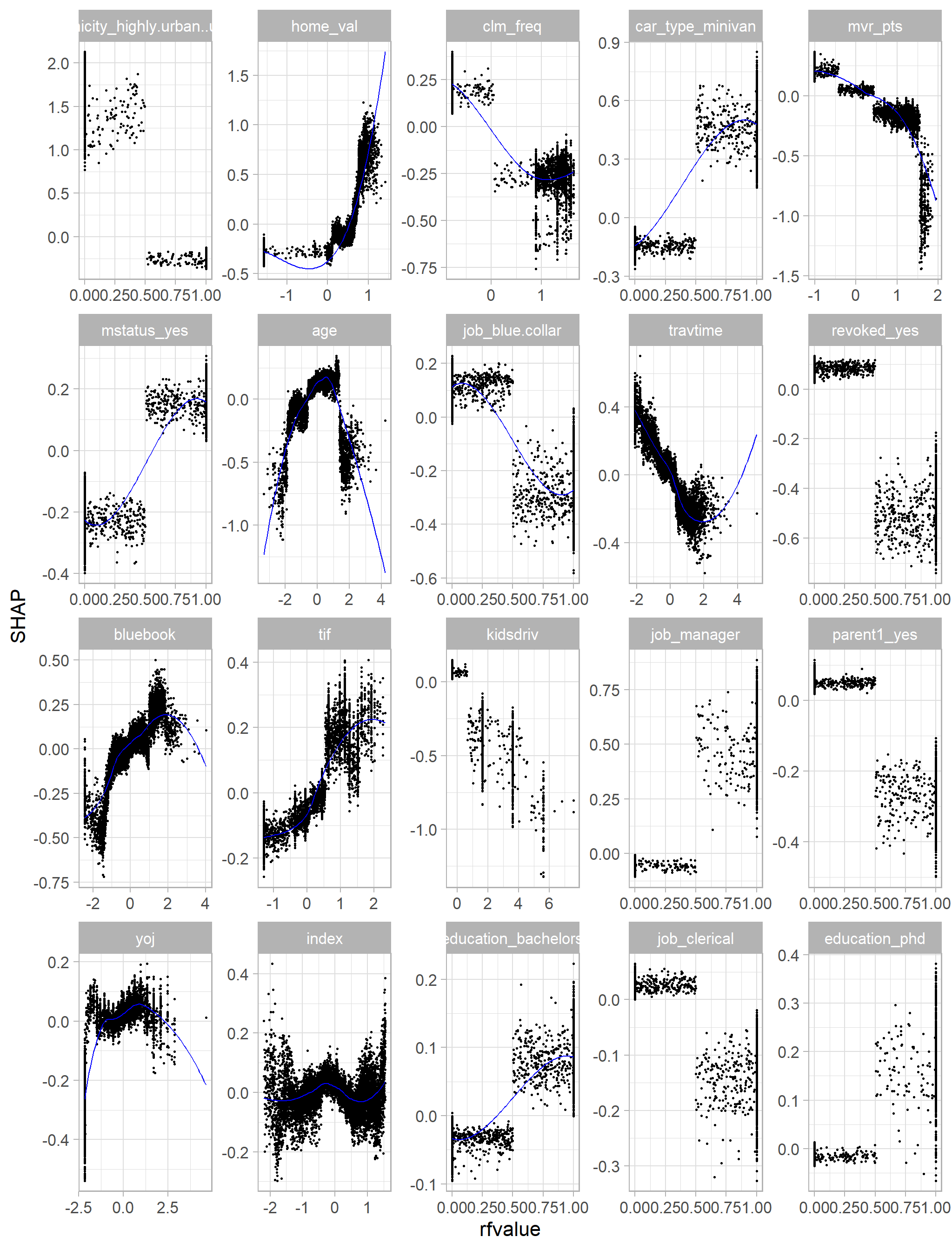| First 6 rows of bloodPressure data | |||||||||||||||||||||||||
|---|---|---|---|---|---|---|---|---|---|---|---|---|---|---|---|---|---|---|---|---|---|---|---|---|---|
| INDEX | TARGET_FLAG | TARGET_AMT | KIDSDRIV | AGE | HOMEKIDS | YOJ | INCOME | PARENT1 | HOME_VAL | MSTATUS | SEX | EDUCATION | JOB | TRAVTIME | CAR_USE | BLUEBOOK | TIF | CAR_TYPE | RED_CAR | OLDCLAIM | CLM_FREQ | REVOKED | MVR_PTS | CAR_AGE | URBANICITY |
| 1 | 0 | 0 | 0 | 60 | 0 | 11 | $67,349 | No | $0 | z_No | M | PhD | Professional | 14 | Private | $14,230 | 11 | Minivan | yes | $4,461 | 2 | No | 3 | 18 | Highly Urban/ Urban |
| 2 | 0 | 0 | 0 | 43 | 0 | 11 | $91,449 | No | $257,252 | z_No | M | z_High School | z_Blue Collar | 22 | Commercial | $14,940 | 1 | Minivan | yes | $0 | 0 | No | 0 | 1 | Highly Urban/ Urban |
| 4 | 0 | 0 | 0 | 35 | 1 | 10 | $16,039 | No | $124,191 | Yes | z_F | z_High School | Clerical | 5 | Private | $4,010 | 4 | z_SUV | no | $38,690 | 2 | No | 3 | 10 | Highly Urban/ Urban |
| 5 | 0 | 0 | 0 | 51 | 0 | 14 | NA | No | $306,251 | Yes | M | <High School | z_Blue Collar | 32 | Private | $15,440 | 7 | Minivan | yes | $0 | 0 | No | 0 | 6 | Highly Urban/ Urban |
| 6 | 0 | 0 | 0 | 50 | 0 | NA | $114,986 | No | $243,925 | Yes | z_F | PhD | Doctor | 36 | Private | $18,000 | 1 | z_SUV | no | $19,217 | 2 | Yes | 3 | 17 | Highly Urban/ Urban |
| 7 | 1 | 2946 | 0 | 34 | 1 | 12 | $125,301 | Yes | $0 | z_No | z_F | Bachelors | z_Blue Collar | 46 | Commercial | $17,430 | 1 | Sports Car | no | $0 | 0 | No | 0 | 7 | Highly Urban/ Urban |
Modeling Auto insuarance using Machine Learning : Xgboost
Glimpse of the data
Comments
- the data looks really dirty with a lot of bad formatting
Data cleaning
out_new<-out_new %>%
select(-INDEX) |>
mutate(INCOME = as.numeric(gsub('[$,]','',INCOME)),
HOME_VAL = as.numeric(gsub('[$,]','',HOME_VAL)),
BLUEBOOK = as.numeric(gsub('[$,]','',BLUEBOOK)),
OLDCLAIM = as.numeric(gsub('[$,]','',OLDCLAIM)),
PARENT1 = tolower(gsub('[z_<]','', PARENT1)),
MSTATUS = tolower(gsub('[z_<]','', MSTATUS)),
SEX = tolower(gsub('[z_<]','', SEX)),
EDUCATION = tolower(gsub('[z_<]','', EDUCATION)),
JOB = tolower(gsub('[z_<]','', JOB)),
CAR_USE = tolower(gsub('[z_<]','', CAR_USE)),
CAR_TYPE = tolower(gsub('[z_<]','', CAR_TYPE)),
RED_CAR = tolower(gsub('[z_<]','', RED_CAR)),
REVOKED = tolower(gsub('[z_<]','', REVOKED)),
URBANICITY = tolower(gsub('[z_<]','', URBANICITY)))
colnames(out_new) <- tolower(colnames(out_new))
dict <- read_xlsx('DataDictionary_Insurance.xlsx')
knitr::kable(dict, format = 'pandoc')| VARIABLE NAME | DEFINITION | THEORETICAL EFFECT |
|---|---|---|
| INDEX | Identification Variable (do not use) | None |
| TARGET_FLAG | Was Car in a crash? 1=YES 0=NO | None |
| TARGET_AMT | If car was in a crash, what was the cost | None |
| AGE | Age of Driver | Very young people tend to be risky. Maybe very old people also. |
| BLUEBOOK | Value of Vehicle | Unknown effect on probability of collision, but probably effect the payout if there is a crash |
| CAR_AGE | Vehicle Age | Unknown effect on probability of collision, but probably effect the payout if there is a crash |
| CAR_TYPE | Type of Car | Unknown effect on probability of collision, but probably effect the payout if there is a crash |
| CAR_USE | Vehicle Use | Commercial vehicles are driven more, so might increase probability of collision |
| CLM_FREQ | #Claims(Past 5 Years) | The more claims you filed in the past, the more you are likely to file in the future |
| EDUCATION | Max Education Level | Unknown effect, but in theory more educated people tend to drive more safely |
| HOMEKIDS | #Children @Home | Unknown effect |
| HOME_VAL | Home Value | In theory, home owners tend to drive more responsibly |
| INCOME | Income | In theory, rich people tend to get into fewer crashes |
| JOB | Job Category | In theory, white collar jobs tend to be safer |
| KIDSDRIV | #Driving Children | When teenagers drive your car, you are more likely to get into crashes |
| MSTATUS | Marital Status | In theory, married people drive more safely |
| MVR_PTS | Motor Vehicle Record Points | If you get lots of traffic tickets, you tend to get into more crashes |
| OLDCLAIM | Total Claims(Past 5 Years) | If your total payout over the past five years was high, this suggests future payouts will be high |
| PARENT1 | Single Parent | Unknown effect |
| RED_CAR | A Red Car | Urban legend says that red cars (especially red sports cars) are more risky. Is that true? |
| REVOKED | License Revoked (Past 7 Years) | If your license was revoked in the past 7 years, you probably are a more risky driver. |
| SEX | Gender | Urban legend says that women have less crashes then men. Is that true? |
| TIF | Time in Force | People who have been customers for a long time are usually more safe. |
| TRAVTIME | Distance to Work | Long drives to work usually suggest greater risk |
| URBANICITY | Home/Work Area | Unknown |
| YOJ | Years on Job | People who stay at a job for a long time are usually more safe |
# test <- read_csv('logit_insurance_test.csv')Explanatory data analysis
Visualise the target variable
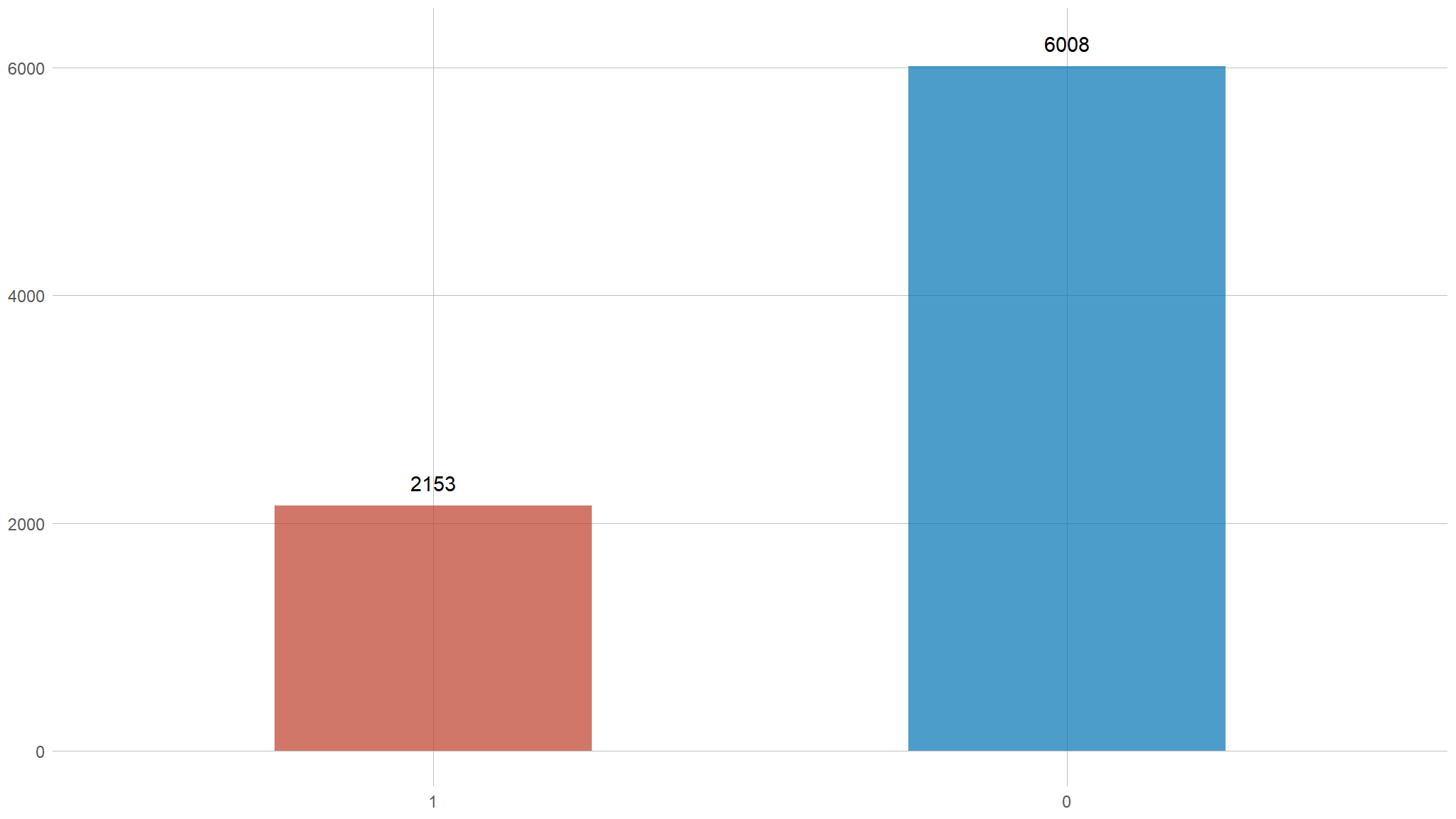
- our dataset is not really balanced !!
Relationship between target flag and car type
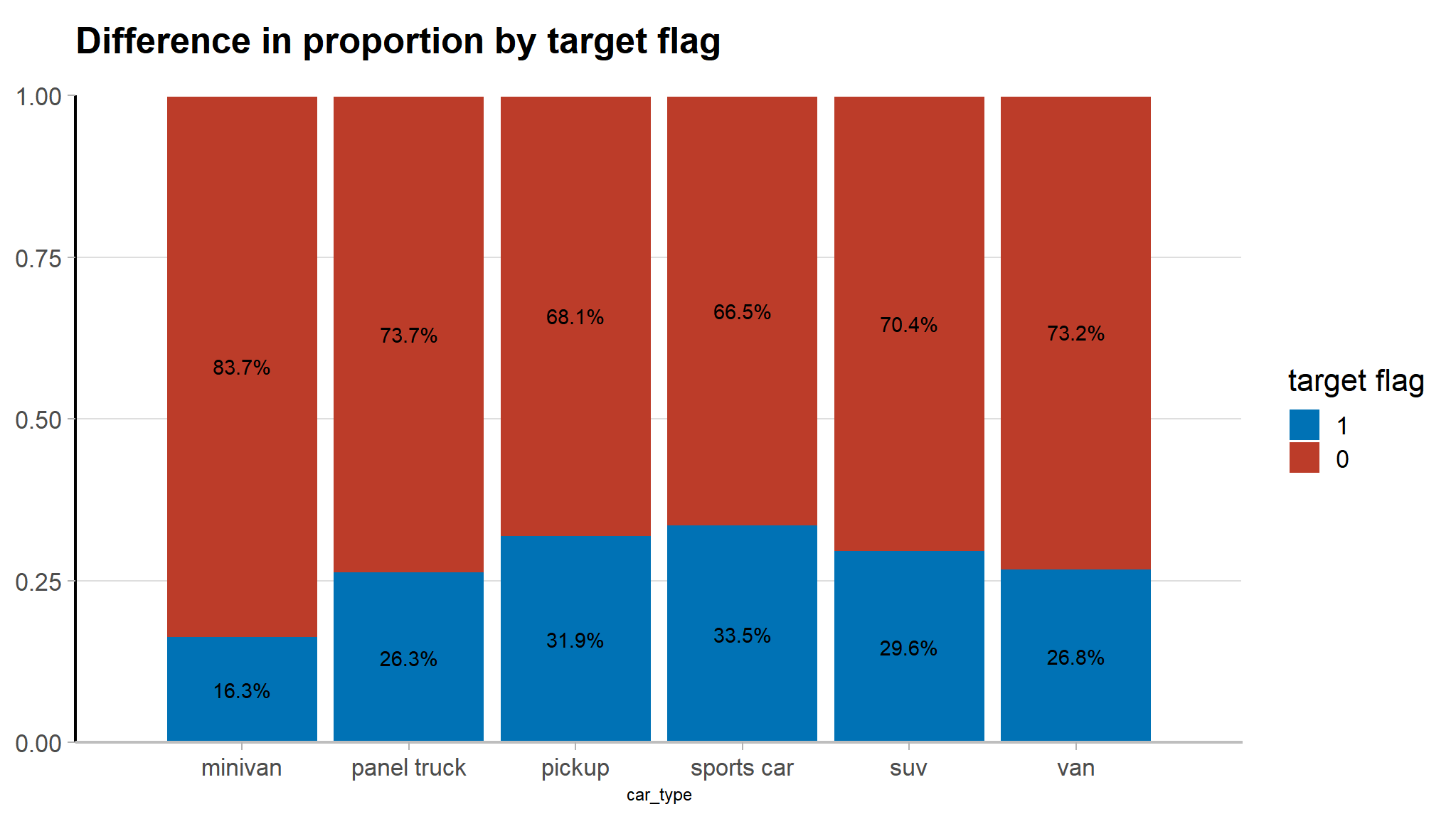
- sports cars are at a high risk of being involved in car accidents
distribution of target by education
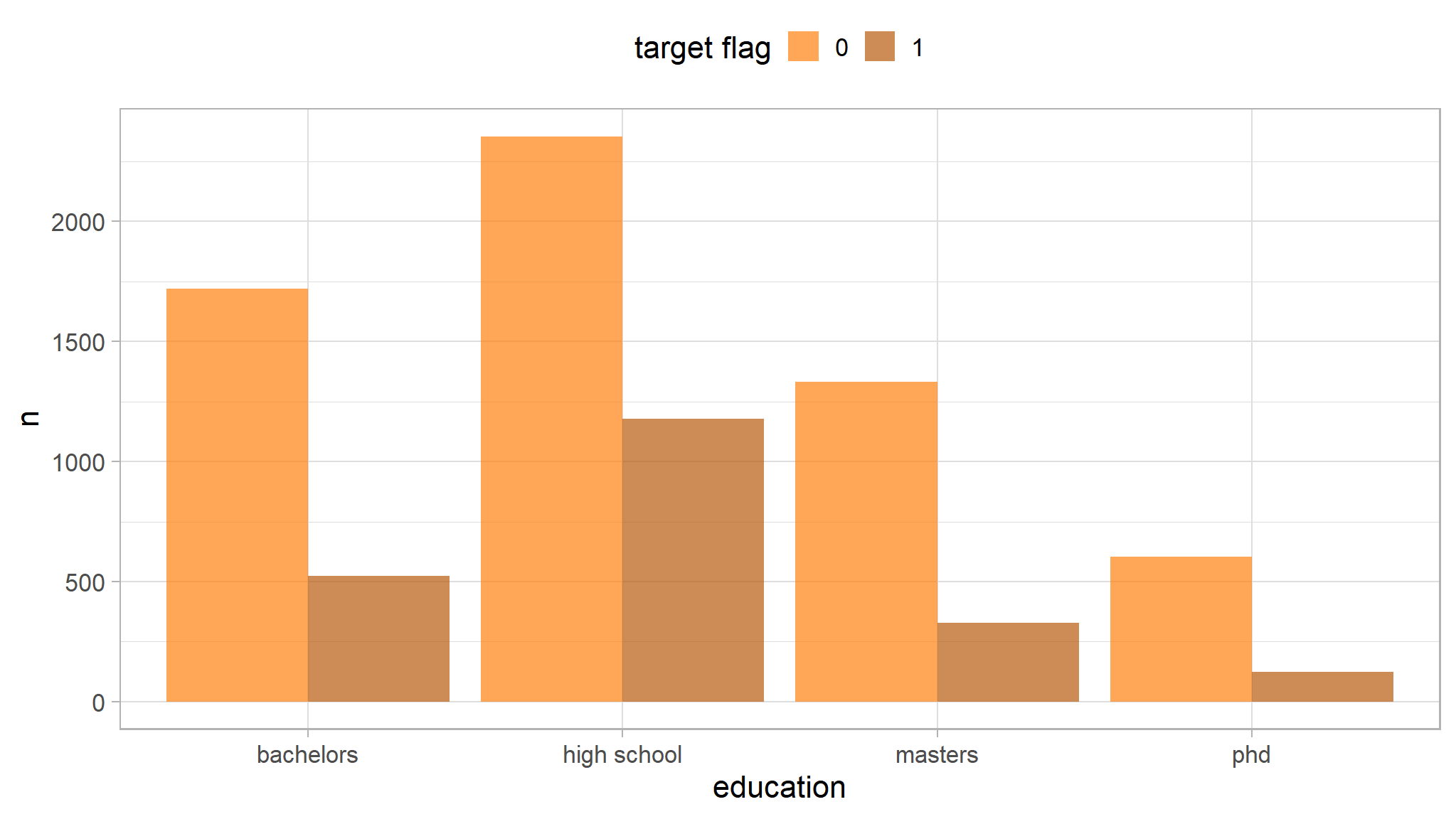
- the greatest proportion of those involved in accidents were students in high school
Relationship between target flag and job
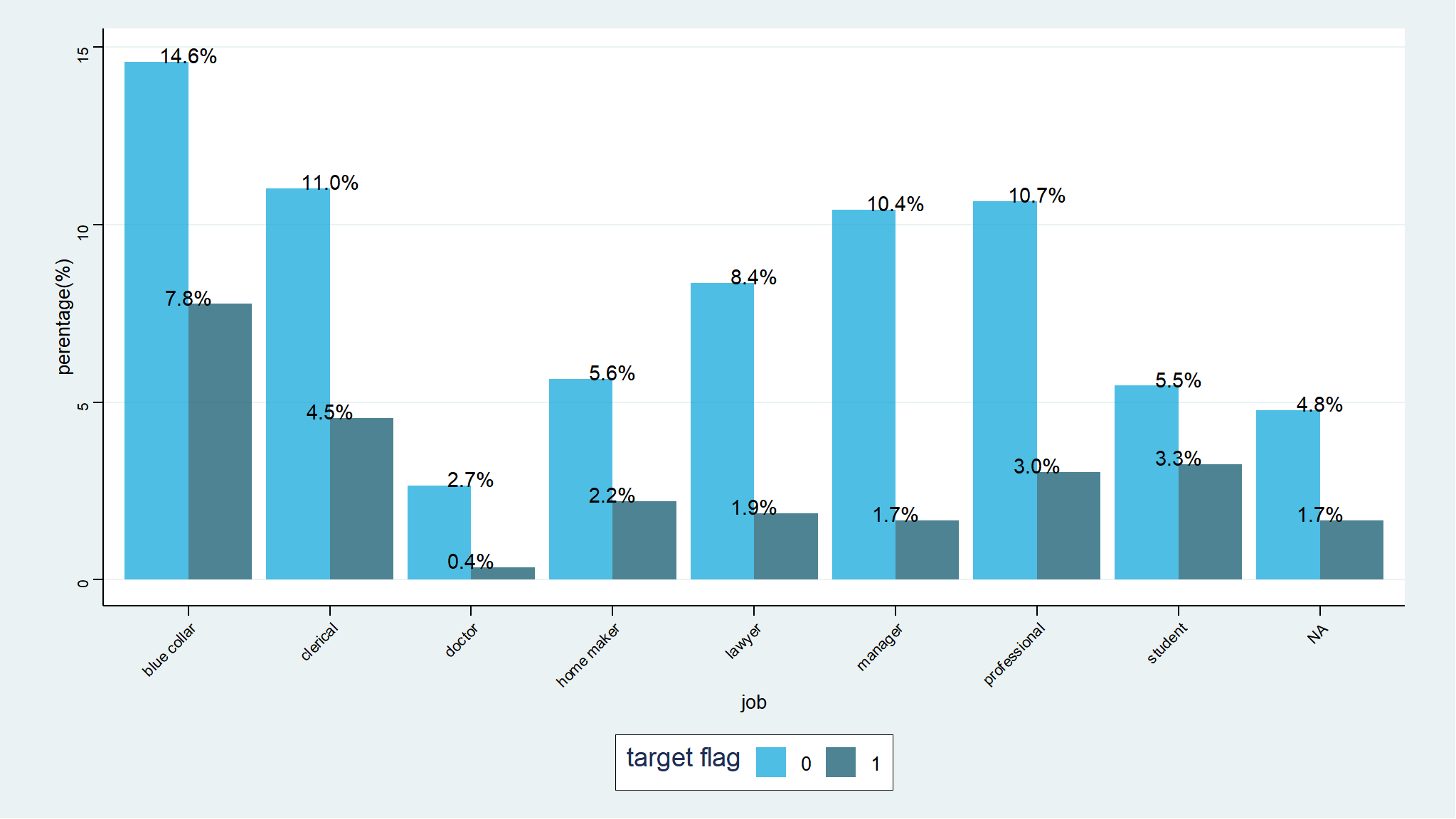
- blue collar guys are more prone to accidents
Distribution of numeric variables
- the following are density plots for variables that have been log transformed
numeric_vars <- out_new |>
select_if(is.numeric) |>
select(-index) |>
mutate(target_flag=factor(target_flag,levels=c("0","1"))) |>
pivot_longer(!target_flag, names_to = "metric", values_to = "value")
# Density plot
numeric_vars %>%
ggplot(mapping = aes(x = value, color = target_flag)) +
geom_density() +
scale_x_log10() +
labs(color = "") +
theme(legend.position = "top") +
facet_wrap(~ metric, scales = "free")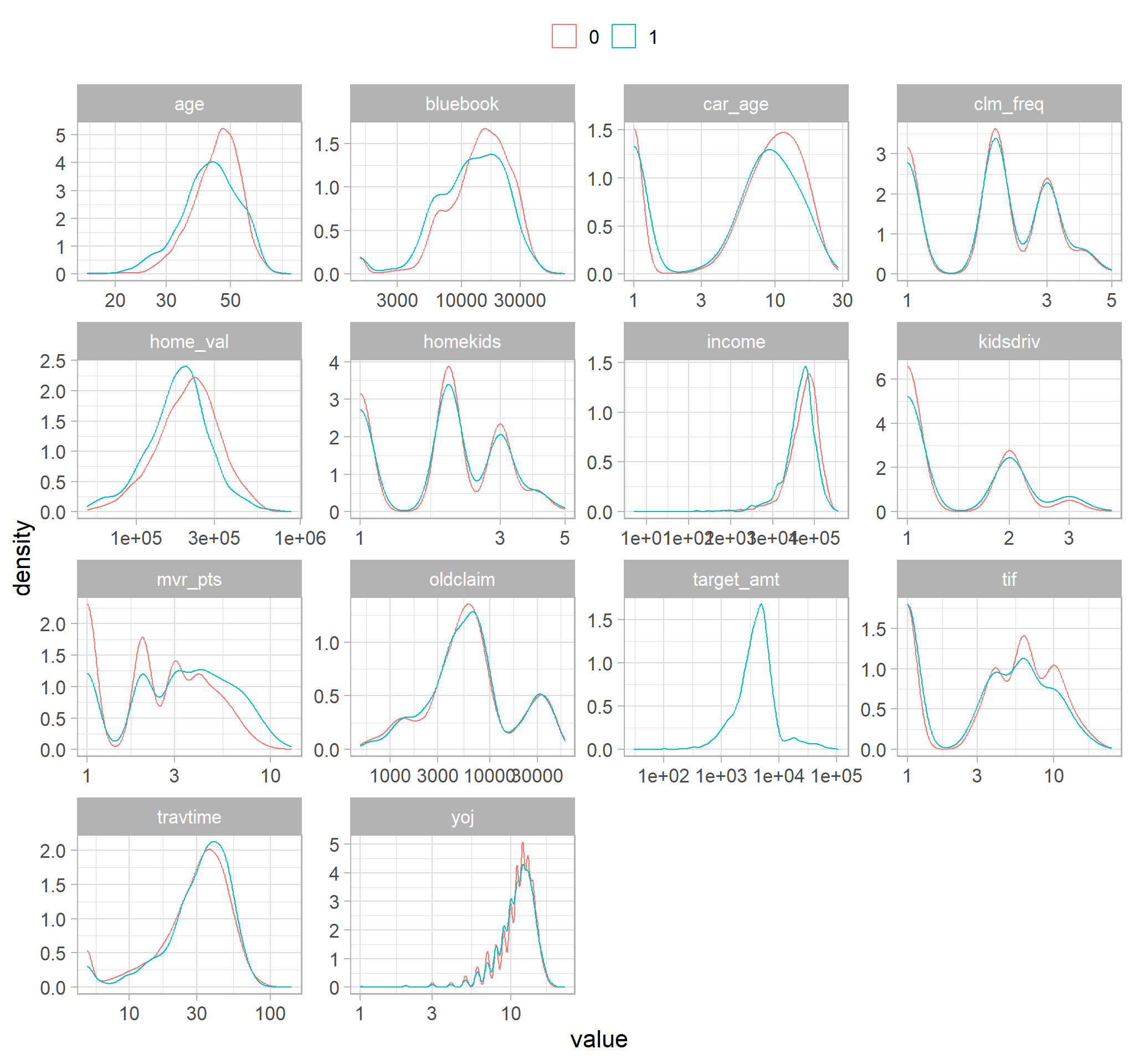
# Use ROc_AUC to determine how well each numeric predictor
# would sway opinions
numeric_vars %>%
group_by(metric) %>%
roc_auc(target_flag, value, event_level = "second") %>%
mutate(metric = fct_reorder(metric, .estimate)) %>%
ggplot(mapping = aes(x = .estimate, y = metric)) +
geom_point() +
geom_vline(aes(xintercept = .5)) +
labs(
x = "AUC estimates of crashing",
title = "How predictive is each numeric predictor by itself?",
subtitle = ">.5 means positively influences crashing and <.5 means negatively influences crashing"
)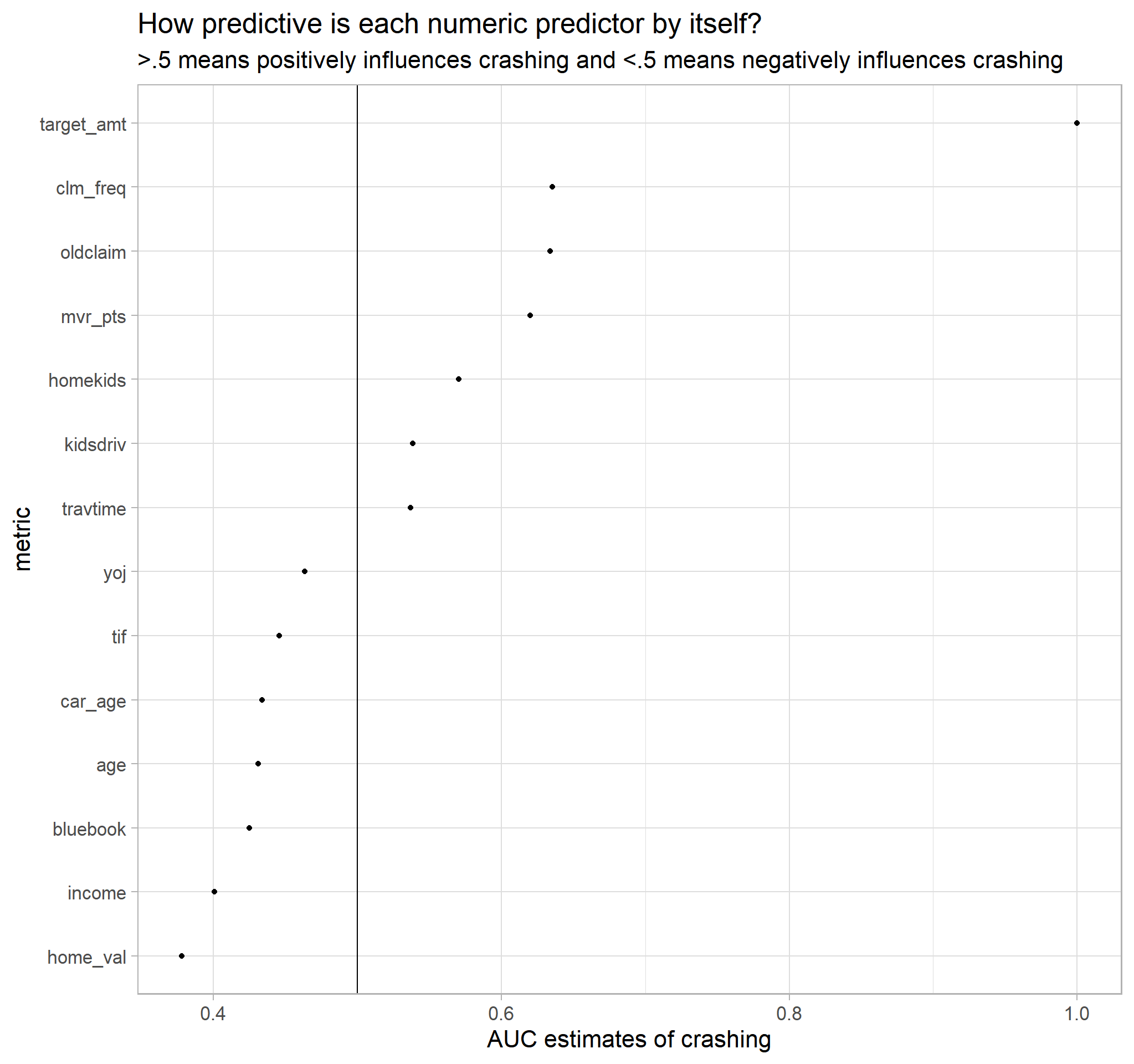
MVR_PTSis greater than .5 hence if you get lots of traffic tickets you tend to get into more crashesTRAVTIMEis greater than .5 hence long drives to work usually suggest greater riskOLD CLAIMis greater tha .5 suggesting also that if your total payout over the past five years was high ,this suggests future payouts will be highclaim_freqis greater than .5 also suggesting that the more claims you filled in the past the more you are likely to file in the future
Modeling
Specifying a Xgboost model
# Stratified split based on opinion ban
auto_split<-out_new |>
mutate(target_flag=as.factor(target_flag))|>
initial_split(strata = target_flag, prop = 0.7)
# Obtain train and test sets
train <- training(auto_split)
test <- testing(auto_split)
# Print out observations in each category
glue(
'The training set has {nrow(train)} observations \n',
'The testing set has {nrow(test)} observations'
)
#> The training set has 5712 observations
#> The testing set has 2449 observations10 Fold cross validation
train_folds <- vfold_cv(data = train, v = 10)feature engineering entails reformatting predictor values to make them easier for a model to use effectively. The following transformation steps will be done before refining the model further down the line:
prep_juice <- function(recipe){
recipe |>
prep() |>
juice()
}
# Data preprocessing with recipes
boost_recipe <- recipe(target_flag ~., data=train) |>
step_select(!target_amt) |>
step_impute_bag(all_numeric_predictors())|>#impute numerical data
step_impute_mode(all_nominal_predictors())|>#impute nominal data
step_YeoJohnson(all_numeric_predictors())|># approximate near normal distributions (optional here)
step_normalize(all_numeric_predictors())|># center and scale numerical vars
step_dummy(all_nominal_predictors(), -all_outcomes(), one_hot = TRUE)|># keep ref levels with one hot
step_nzv(all_numeric_predictors())|># remove numeric vars that have zero variance (single unique value)
step_corr(all_predictors(), threshold = 0.5, method = 'spearman')|># address collinearity
themis::step_smote(target_flag) # rebalance the dataset based on the response variableCreate boosted tree model specification
boost_spec <- boost_tree(
mtry = tune(),
trees = tune(),
#min_n = tune(),
#tree_depth = tune(),
learn_rate = 0.01,
#loss_reduction = tune(),
#sample_size = tune(),
#stop_iter = tune()
) |>
set_engine("xgboost") |>
set_mode("classification")
# Bind recipe and model specification together
boost_wf <- workflow() |>
add_recipe(boost_recipe) |>
add_model(boost_spec)
# Print workflow
boost_wf
#> ══ Workflow ════════════════════════════════════════════════════════════════════
#> Preprocessor: Recipe
#> Model: boost_tree()
#>
#> ── Preprocessor ────────────────────────────────────────────────────────────────
#> 9 Recipe Steps
#>
#> • step_select()
#> • step_impute_bag()
#> • step_impute_mode()
#> • step_YeoJohnson()
#> • step_normalize()
#> • step_dummy()
#> • step_nzv()
#> • step_corr()
#> • step_downsample()
#>
#> ── Model ───────────────────────────────────────────────────────────────────────
#> Boosted Tree Model Specification (classification)
#>
#> Main Arguments:
#> mtry = tune()
#> trees = tune()
#> learn_rate = 0.01
#>
#> Computational engine: xgboostdoParallel::registerDoParallel()
set.seed(2056)
# Evaluation metrics during tuning
eval_metrics <- metric_set(mn_log_loss, accuracy)
# Efficient grid search via racing
xgb_race <- tune_race_anova(
object = boost_wf,
resamples = train_folds,
metrics = eval_metrics,
# Try out 20 different hyperparameter combinations
grid = 20,
control = control_race(
verbose_elim = TRUE
)
)
beepr::beep(9)
#saveRDS(xgb_race, "smot# Plot racing results
plot_race(xgb_race)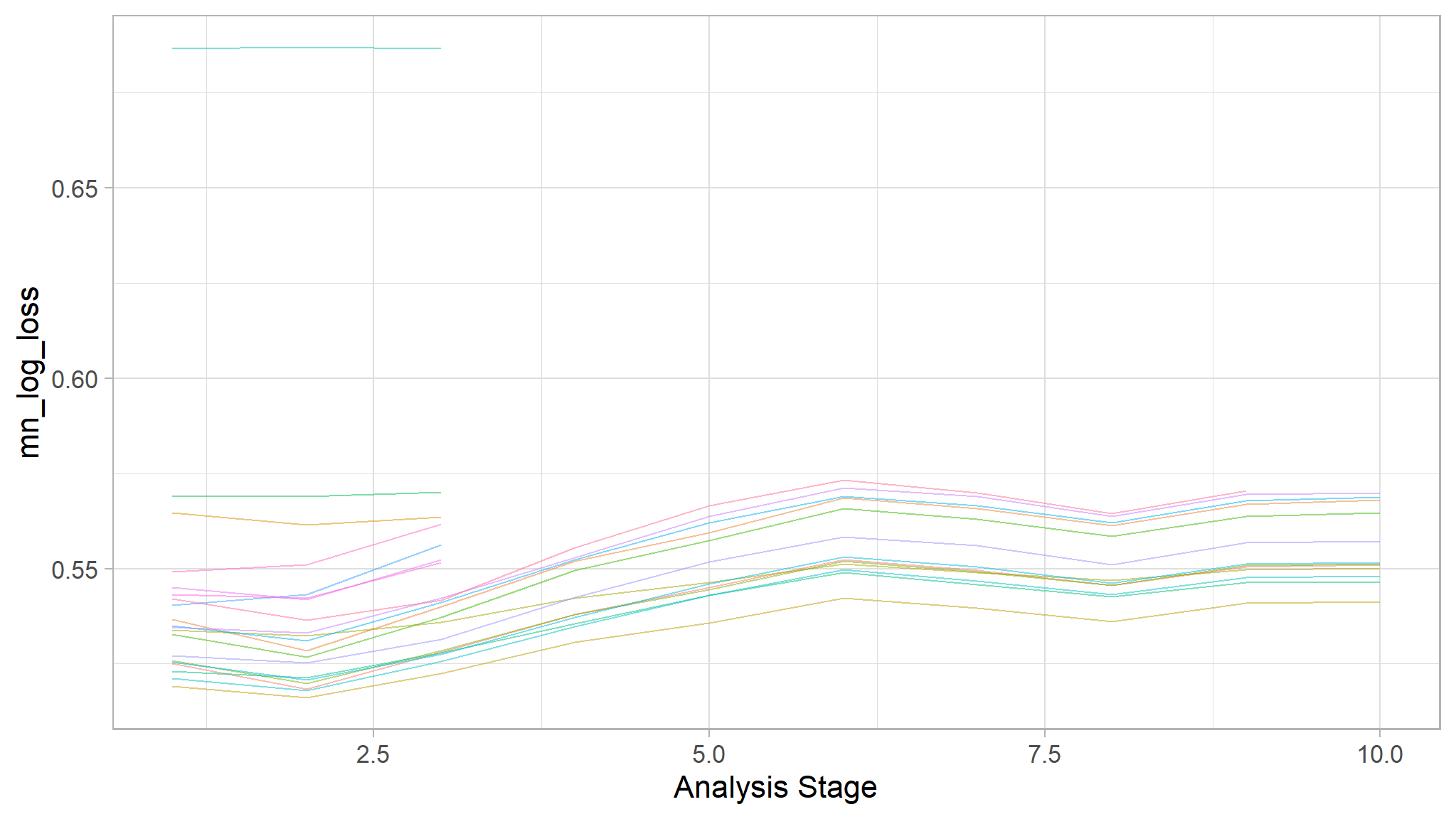
- we observe an incremental elimination of tuning parameters that may not have likely improved model perfomance
Accuracy of the models
xgb_race |>
show_best(metric = "accuracy")
#> # A tibble: 5 × 8
#> mtry trees .metric .estimator mean n std_err .config
#> <int> <int> <chr> <chr> <dbl> <int> <dbl> <chr>
#> 1 4 741 accuracy binary 0.714 10 0.00803 Preprocessor1_Model04
#> 2 7 1086 accuracy binary 0.710 10 0.00940 Preprocessor1_Model06
#> 3 5 295 accuracy binary 0.709 10 0.00619 Preprocessor1_Model05
#> 4 8 973 accuracy binary 0.709 10 0.00844 Preprocessor1_Model01
#> 5 8 1768 accuracy binary 0.707 10 0.00889 Preprocessor1_Model02# Plot
xgb_race |>
collect_metrics() |>
select(mtry, trees, .metric, mean) |>
filter(.metric == "accuracy") |>
pivot_longer(!c(mean, .metric), names_to = "metrics", values_to = "values") |>
ggplot(mapping = aes(x = values, y = mean)) +
geom_point(size = 2, color = "darkorange", alpha = 0.7) +
geom_line(color = "dodgerblue", size = 1.2, alpha = 0.7) +
labs(y = "accuracy") +
facet_wrap(vars(metrics), scales = "free_x")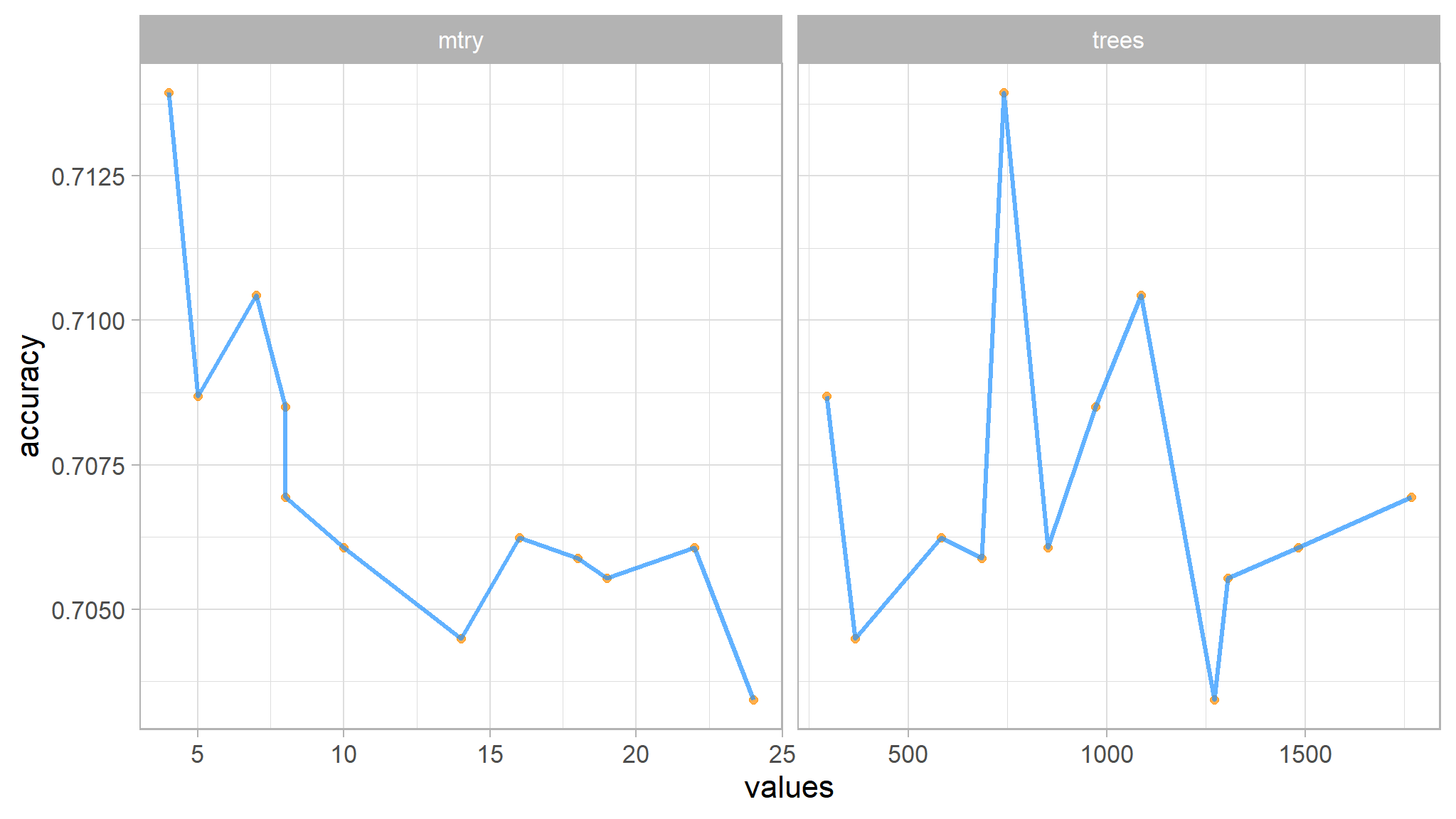
- how accuracy varies with different combinations of
mtry and trees
Mean log loss
# Tibble
xgb_race |>
show_best(metric = "mn_log_loss")
#> # A tibble: 5 × 8
#> mtry trees .metric .estimator mean n std_err .config
#> <int> <int> <chr> <chr> <dbl> <int> <dbl> <chr>
#> 1 4 741 mn_log_loss binary 0.541 10 0.00784 Preprocessor1_Model04
#> 2 14 367 mn_log_loss binary 0.547 10 0.00747 Preprocessor1_Model09
#> 3 16 584 mn_log_loss binary 0.548 10 0.00860 Preprocessor1_Model11
#> 4 5 295 mn_log_loss binary 0.550 10 0.00546 Preprocessor1_Model05
#> 5 8 973 mn_log_loss binary 0.551 10 0.00904 Preprocessor1_Model01
# Plot
xgb_race |>
collect_metrics() |>
select(mtry, trees, .metric, mean) |>
filter(.metric == "mn_log_loss") |>
pivot_longer(!c(mean, .metric), names_to = "metrics", values_to = "values") |>
ggplot(mapping = aes(x = values, y = mean)) +
geom_point(size = 2, color = "dodgerblue", alpha = 0.7) +
geom_line(color = "darkorange", size = 1.2, alpha = 0.7) +
labs(y = "mn_log_loss") +
facet_wrap(vars(metrics), scales = "free_x")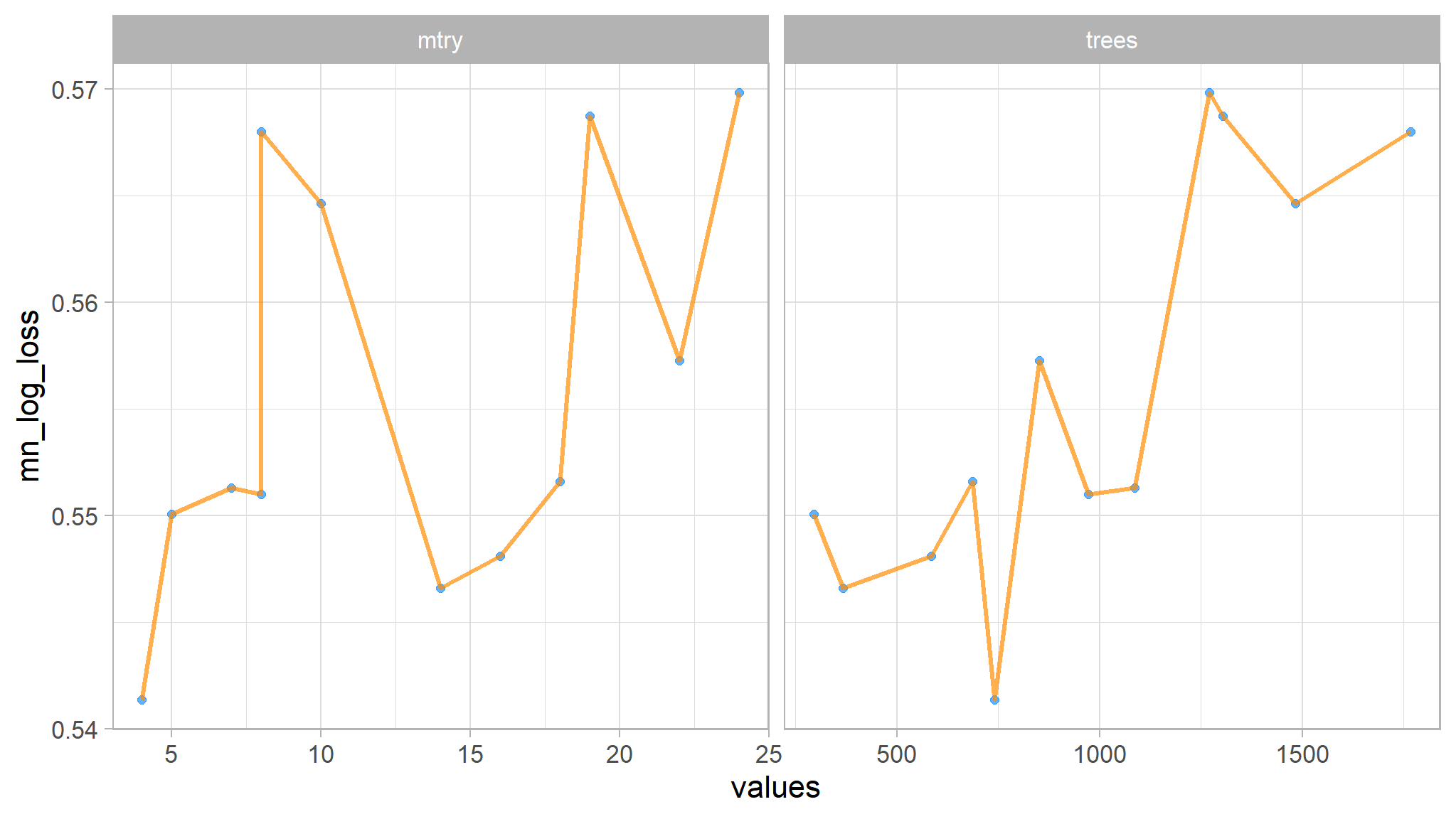
# Finalize workflow
final_boost_wf <- boost_wf |>
finalize_workflow(select_best(xgb_race, metric = "mn_log_loss" #mn_log_loss
))
# Train then test
xgb_model <- final_boost_wf |>
last_fit(auto_split, metrics = metric_set(accuracy, recall, spec, ppv, roc_auc, mn_log_loss, f_meas))
# Collect metrics
xgb_model |>
collect_metrics()
#> # A tibble: 7 × 4
#> .metric .estimator .estimate .config
#> <chr> <chr> <dbl> <chr>
#> 1 accuracy binary 0.710 Preprocessor1_Model1
#> 2 recall binary 0.684 Preprocessor1_Model1
#> 3 spec binary 0.785 Preprocessor1_Model1
#> 4 ppv binary 0.899 Preprocessor1_Model1
#> 5 f_meas binary 0.777 Preprocessor1_Model1
#> 6 roc_auc binary 0.819 Preprocessor1_Model1
#> 7 mn_log_loss binary 0.533 Preprocessor1_Model1Collect metric results
# Plot confusion matrix
xgb_model |>
collect_predictions() |>
conf_mat(truth = target_flag, estimate = .pred_class) |>
autoplot(type = "heatmap")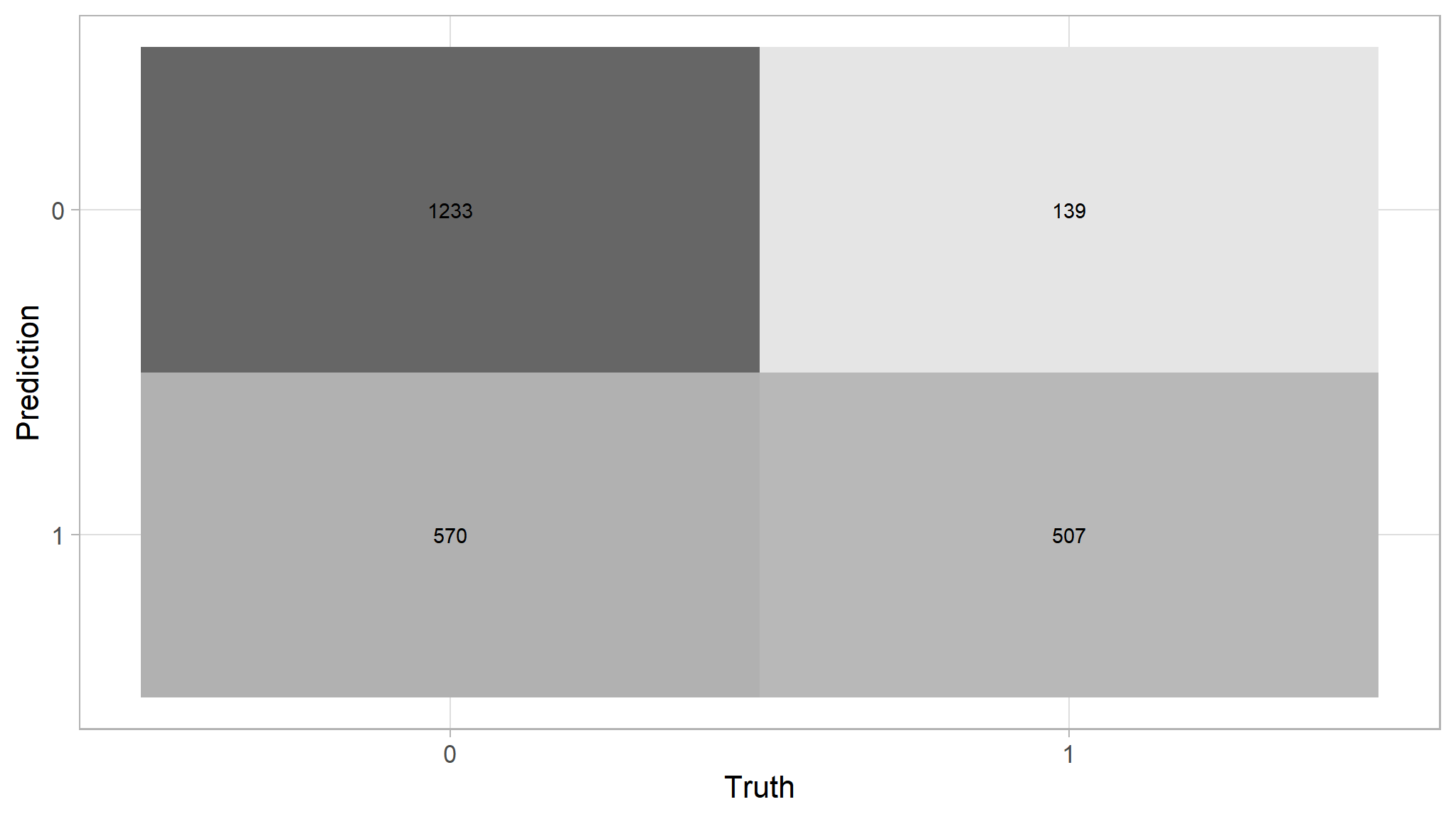
# Prettier?
update_geom_defaults(geom = "rect", new = list(fill = "midnightblue", alpha = 0.7))
xgb_model |>
collect_predictions() |>
conf_mat(target_flag, .pred_class) |>
autoplot()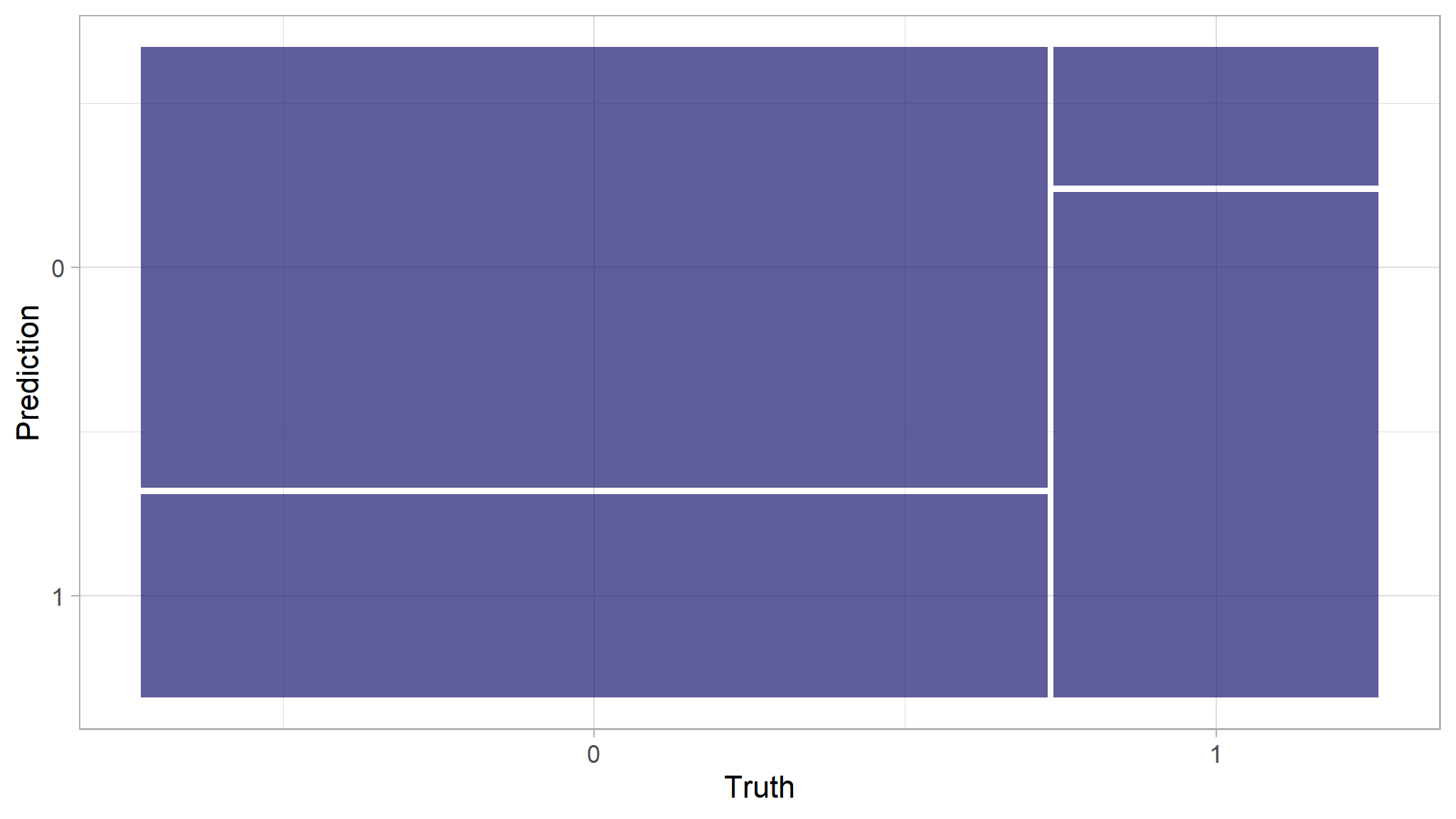
# Extract trained workflow
xgb_wf <- xgb_model |>
extract_workflow()The performance metrics considered are:
Recall: TP/(TP + FN) defined as the proportion of positive results out of the number of samples which were actually positive. Also known as sensitivity.
Specificity: TN/(TN + FP) defined as the proportion of negative results out of the number of samples which were actually negative.
Precision: TP/(TP + FP) defined as the proportion of predicted positives that are actually positive. Also called positive predictive value
Accuracy: TP + TN/(TP + TN + FP + FN) The percentage of labels predicted accurately for a sample.
F Measure: A weighted average of the precision and recall, with best being 1 and worst being 0.
Variable Importance/Permutation feature importance plots are one way of understanding which predictor has the largest effect on the model outcomes. The main idea is to measure how much does a model’s performance changes if the effect of a selected explanatory variable, or of a group of variables, is removed. To remove the effect, we use perturbations, like resampling from an empirical distribution or permutation of the values of the variable.If a variable is important, then we expect that, after permuting/shuffling the values of the variable, the model’s performance will worsen. The larger the change in the performance, the more important is the variable. Please see Explanatory Model Analysis and Interpretable Machine Learning
The methods may be applied for several purposes.
Model simplification: variables that do not influence a model’s predictions may be excluded from the model.
Model exploration: comparison of variables’ importance in different models may help in discovering interrelations between the variables. Also, the ordering of variables in the function of their importance is helpful in deciding in which order should we perform further model exploration.
Domain-knowledge-based model validation: identification of the most important variables may be helpful in assessing the validity of the model based on domain knowledge.
Knowledge generation: identification of the most important variables may lead to the discovery of new factors involved in a particular mechanism.
# Load saved model
#xgb_wf <- readRDS("smote_boost_hnwf")
options(scipen = 999)
# Extract variable importance
library(vip)
vi <- xgb_wf |>
extract_fit_parsnip() |>
vi()
vi
#> # A tibble: 30 × 2
#> Variable Importance
#> <chr> <dbl>
#> 1 urbanicity_highly.urban..urban 0.148
#> 2 home_val 0.106
#> 3 clm_freq 0.0796
#> 4 bluebook 0.0730
#> 5 age 0.0682
#> 6 mvr_pts 0.0666
#> 7 travtime 0.0602
#> 8 index 0.0549
#> 9 car_type_minivan 0.0412
#> 10 yoj 0.0375
#> # ℹ 20 more rowsLet’s represent the above as Variable Importance Plots:
# Make Variable Importance Plots
vi |>
slice_max(Importance, n = 42) %>%
mutate(Variable = fct_reorder(Variable, Importance)) %>%
ggplot(mapping = aes(y = Variable, x = Importance)) +
geom_point(size = 3, color = "dodgerblue") +
geom_segment(aes(y = Variable, yend = Variable, x = 0, xend = Importance), size = 2, color = "dodgerblue", alpha = 0.7 ) +
ggtitle(paste("Variable Importance plot of top", round(nrow(vi)/2), "variables")) +
theme(plot.title = element_text(hjust = 0.5))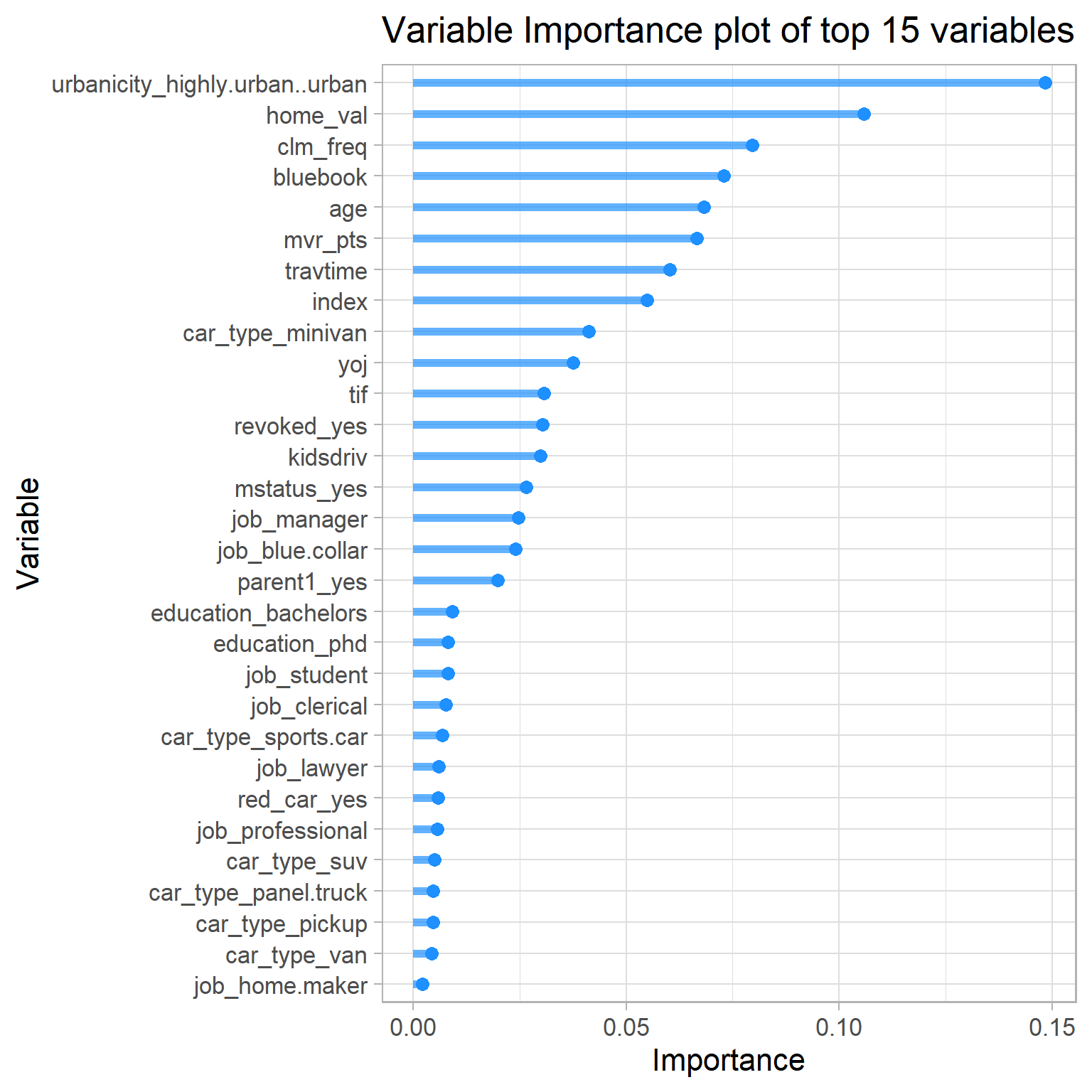
- as seen earlier , claim freqency has a significant predictive power
- Motor vehicle record points also has some great predictive power just as seen from the individual
AUCplot seen earlier - travel time has significant effect as well
Shapley Additive exPLanations (SHAP)
- SHAP is based on the idea of averaging the value of a variable’s attribution over all (or a large number of) possible orderings.
- As such, permutation feature importance is based on decrease in model’s performance with shuffling while SHAP is based on magnitude of feature attributions.
- the code below calculates the SHAP values for the top 25 variables ranked by mean SHAP.
# SHAP for xgboost
library(SHAPforxgboost)
# Prepare shap values for plotting. Requires a matrix
opinion_shap <- shap.prep(
# Actual Boost engine
xgb_model = xgb_wf |>
extract_fit_engine(),
# predictors used to calculate SHAP values
X_train = boost_recipe |>
prep() |>bake(has_role("predictor"),
new_data = NULL,
composition = "matrix"),
top_n = round(nrow(vi)/2) + 10
)
shap.plot.summary(opinion_shap)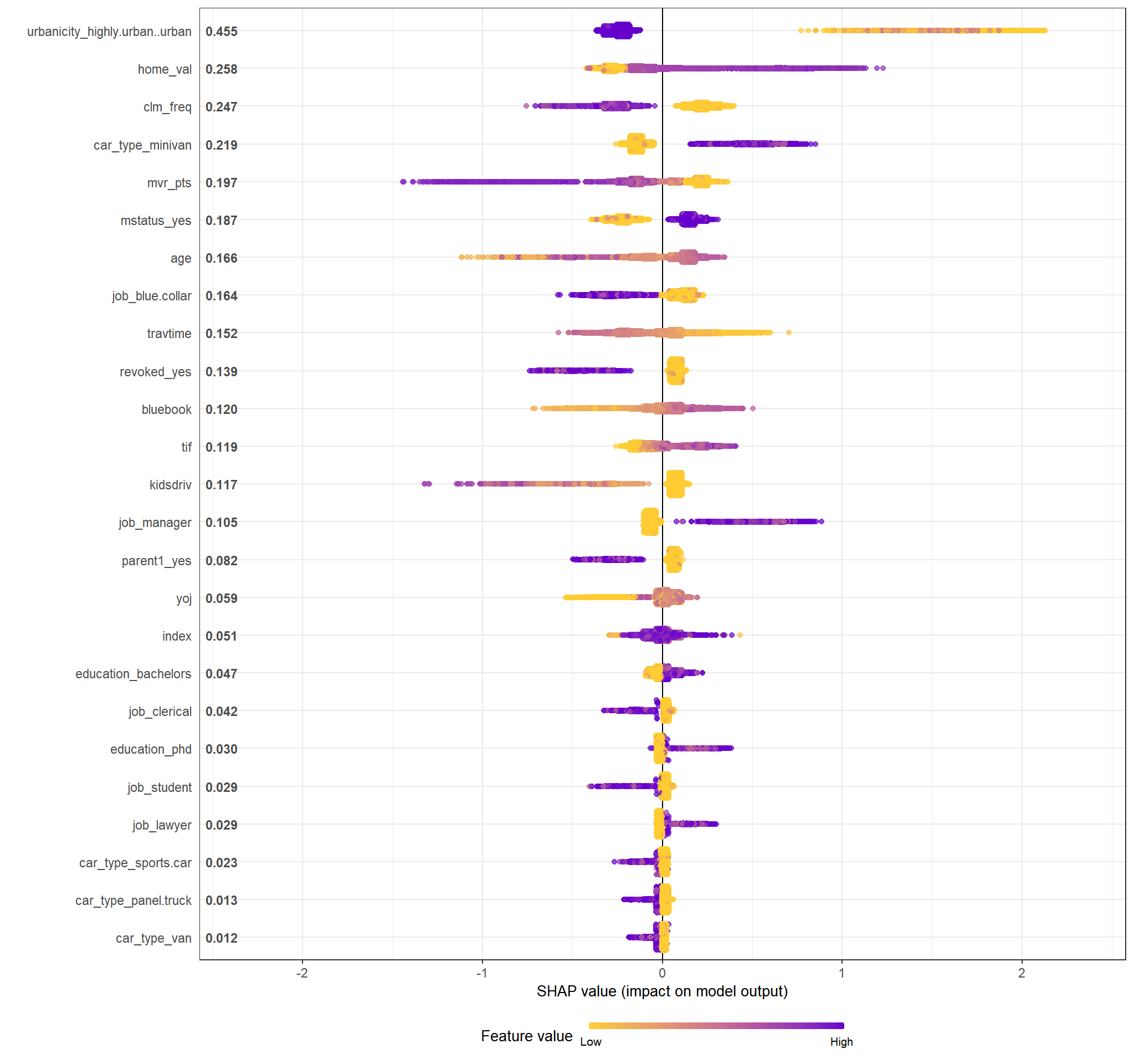
Your regular reminder: All effects describe the behavior of the model and are not necessarily causal in the real world.
opinion_shap |>
filter(variable %in% (opinion_shap |>distinct(variable) |>slice_head(n = 20) |>pull())) |>
ggplot(mapping = aes(x = rfvalue, y = value)) +
geom_point(size = 0.5) +
geom_smooth(method = "loess", se = F, color = "blue", alpha = 0.7, lwd = 0.4) +
facet_wrap(vars(variable), scales = "free") +
ylab("SHAP")